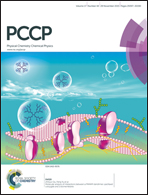Computational modeling of self-trapped electrons in rutile TiO2†
Abstract
In conjunction with the constrained density functional theory, a valence-bond representation has been employed to model the migration of anionic polaron in bulk rutile TiO2. It was found that the charge delocalization of a self-trapped electron proceeded predominately along the c crystal axis of rutile, thus exhibiting pronounced directional heterogeneity of polaron migration. As a result, the extrapolated polaron activation energies are 0.026 eV and 0.195 eV along the [001] and [111] lattice vectors, respectively. According to the Holstein theory, the difference on the activation energy makes the polaron drift over 100 times faster along the c crystal axis than on the ab crystal plane at room temperature. The notable anisotropy of the anionic polaron was also reflected through the electron paramagnetic resonance (EPR) g-matrix, whose principal component along [001] is substantially smaller than that along [110] or [1![[1 with combining macron]](https://www.rsc.org/images/entities/char_0031_0304.gif) 0]. Finally, the extent of polaron charge was probed by our calculated isotropic hyperfine coupling constants on two groups of crystallographically inequivalent 17O atoms, which manifest distinct strengths of spin–orbit interaction with the unpaired electron.
0]. Finally, the extent of polaron charge was probed by our calculated isotropic hyperfine coupling constants on two groups of crystallographically inequivalent 17O atoms, which manifest distinct strengths of spin–orbit interaction with the unpaired electron.


 Please wait while we load your content...
Please wait while we load your content...